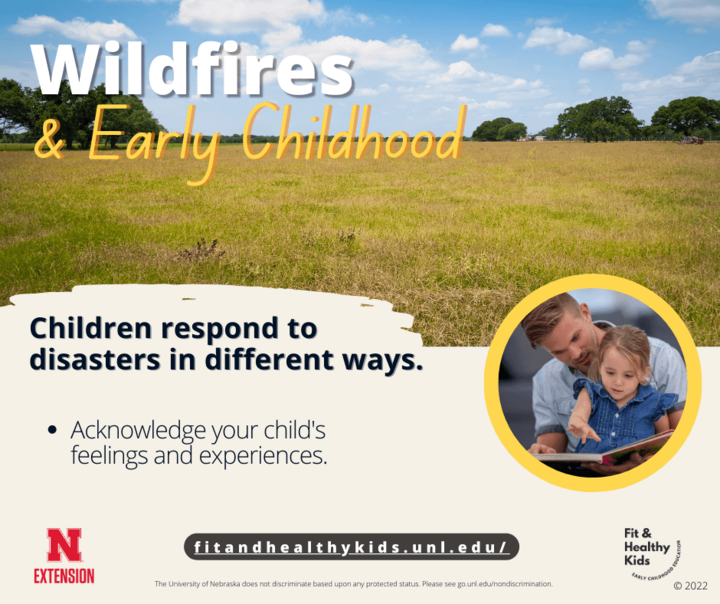As farmers and ranchers in west-central Nebraska begin recovery efforts following the devastating wildfires in late February, Nebraska Extension educators have fielded numerous concerns on how to proceed with the 2024 growing season. This article reviews answers to the questions received so far. If you have a concern about wildfire recovery that is not addressed in the following Q&A, please contact us.
Q: Should I plant now?
A: In croplands, we recommend to plant something as soon as possible. Some are planting oats to get a cover to grow quickly and hold the soil in place. The oats can be used for forage or they can be burned off after planting corn or soybean into them.
In rangelands, reseeding is not recommended. Fires were a common occurrence in grasslands historically and herbaceous plants quickly recover after fire. A team at UNL analyzed all wildfires that burned across the Great Plains between 2000 and 2012 (over 1,300 wildfires) and found that vegetation rapidly recovers after wildfire, even when fires burn under extreme drought conditions. Regions expected to be particularly vulnerable to wildfire, like the Sandhills, have been found to fully recover above-ground biomass within two years of wildfire and extreme drought.
Q: What should I plant?
A: In croplands, if you typically plant corn, sorghum and soybean and are most comfortable with them, we’d recommend sticking to that. If you need forages and are comfortable with planting them, that could be a very wise option this year. We share additional considerations in this article regarding planting into dry conditions.
Corn: For irrigated fields in which pivots have been impacted and you’re unsure if a pivot will be in place this growing season, consider reducing seeding rate to around 18,000 seeds/ac and use a hybrid with greater flex if available. We recommend each person talk with your pivot dealer to determine the potential opportunity for pivot replacement before making your final seeding rate decision.
Soybean: Planting soybean as soon as possible can aid in yields. There really should be no changes to seeding rates. UNL research has consistently shown no reduced yields when planting 120,000 seeds/ac in 30-inch rows in silt-loam soils vs. 180,000 seeds/ac. UNL research has also shown best yields at 1.75-inch depth. Considerations are to plant into moisture. If there’s moisture at one inch after recent rains to get beans germinated before PRE plant herbicides are applied, that could be an option, too. The concern is when soybean is planted shallow into dry soil and rain or irrigation moves PPO-inhibiting herbicide into the seed zone where soybean are imbibing water containing the herbicide.
Sorghum: While a little early to seed sorghum, it can be seeded by mid- to late May. If one is unsure if a pivot will be available, a non-irrigated seeding rate could be planted for this year (around 55,000 seeds/ac, double that for irrigated sorghum.) Figure 1 includes suggestions on sorghum seeding rates from K-State.
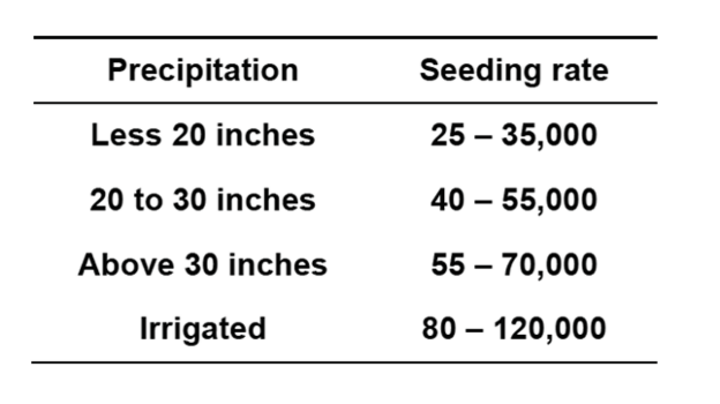
Forages: Annual forage systems are also an option, particularly for those with livestock where forage resources were lost to the fire. The quickest thing to plant right now would be oats. The oats could be grazed, hayed or green-chopped. Once the oats are completed, putting in a warm-season annual like pearl millet, sorghum sudan/forage sorghums or a warm-season annual mix in July can be beneficial. Pearl millet has the smallest stems for allowing a hay crop and also regrowth for grazing. It won’t provide the biomass of some of the forage sorghums that are harder to hay. The regrowth could be grazed through the winter, or if hayed off, a cool-season mix could be planted by Sept. 1 of a small grain like cereal rye, wheat, triticale and/or oats with the addition of brassicas like turnips, collards, radishes or rape. This would provide forage through the winter and early spring.
Should it be a dry season, you may wish to consider forage insurance, which can be purchased based on average rainfall for your area. Learn more in this article.
In rangelands, reseeding is not recommended. Research from the Great Plains shows that dormant-season fires do not reduce forage regrowth and that grassland vegetation quickly recovers following fire.
Should it be a dry season, drought impacts to forage production are more important than the wildfire. The UNL Drought Management Planning page provides a variety of helpful resources for developing a drought management plan.
Q: What happened to the nutrients in my field?
A: In croplands, if dry fertilizer was spread and lying on the surface of fields, it was most likely lost due to fire or wind. If dry fertilizer was incorporated, it will depend on how deep the incorporation and how much topsoil was lost to wind. If fertilizer was injected/knifed in, it most likely is still present. Soil samples either pre-plant or during the growing season will give an indication of how much nitrogen is available to the growing crop.
Nutrients from the residue (whether one year or multiple years from continuous no-till) were most likely lost due to the fire and wind. The nitrogen and sulfur in the residue would have been lost to the atmosphere. The phosphorus and potassium in the residue would remain in the ash if the ash is still present on the field and not removed by wind. In general, research has found that the nutrient content within the residue would not need to be replaced for this year, particularly regarding nitrogen, as the C:N ratio has changed and more mineralization can occur. What we don’t know is the impacts on microbes due to the fire. Our recommendation is not to worry about figuring out nitrogen needs now, but to get something planted if at all possible.
In rangelands, fertilization is not recommended after a fire. Dormant-season fires do not reduce herbaceous production and vegetation quickly recovers after fire. In fact, one effect of fire is increased forage quality of regrowth after the fire. This is one reason why prescribed fire is often integrated with livestock production systems.
Q: Is prevented planting coverage payable on crops that could not be planted due to severe drought conditions?
A: From the Risk Management Agency (RMA): Prevented Planting coverage is provided for drought, failure of the irrigation water supply, failure or breakdown of irrigation equipment or facilities, or the inability to prepare the land for irrigation using the policyholders established irrigation method, due to an insured cause of loss, as provided by the policy. Prevented planting will be provided only if, by the Final Planting Date (or within the Late Planted Period if the insured elected to plant the crop), the policyholder provides verifiable documentation demonstrating the drought conditions that are acceptable to the AIP. AIPs are to take into consideration if the area that is prevented from being planted has insufficient soil moisture for germination of seed or would make insufficient progress toward crop maturity due to a prolonged period of dry weather to achieve the per-acre guarantee on the acreage. In regard to the phrase, "insufficient soil moisture for germination of seed or progress toward crop maturity," there rarely is enough soil moisture at the time a crop is planted to carry the crop to full maturity. Normally, a non-irrigated crop depends on expected seasonal rains throughout the growing season to mature. "Insufficient soil moisture for progress toward maturity" means the crop may germinate but there is insufficient moisture to sustain the germinated plants.
For more information, visit USDA RMA Drought FAQ.
Q: Does RMA have any information regarding wildfires?
A: Please see the RMA Wildfire FAQ resource.
Q: Where can I go for more information on fire and wildfires in rangelands?
A: Please see resources provided by the Great Plains Fire Science Exchange.
Q: How do I determine where soil moisture is in my field or pasture/rangeland?
A: One way is to use a long steel rod with a ball at the top that can be pushed into the soil. A change in the resistance to pushing the rod into the soil will usually indicate the depth of soil water recharge. Soil water recharge to only 1.5 ft by the end April is very low and soil moisture to six ft is very good.
Note: Fields that were irrigated last year will likely be closer to field capacity this spring.
Q: What should I do about invasive and problematic woody plants after the fire?
A: Woody plant encroachment is one of the greatest threats facing grasslands in the Great Plains, and wildfires can result in major reductions in the abundance of invasive and problematic woody plants like eastern redcedar. Best practices after the fire are to quickly remove invasive and problematic trees that remain alive and to manage reestablishing seedlings over the next several years to prevent them from becoming new seed-bearing trees. These practices minimize your rangeland’s exposure to seed dispersal and reduce encroachment problems in future years. In the southern Great Plains, these practices are used after wildfires to reduce woody encroachment in areas that would have otherwise been extremely expensive to restore using mechanical methods alone.
In addition, managing eastern redcedar after wildfire prevents the accumulation of highly volatile woody fuels in rangelands and thereby reduces the risk of damaging wildfires in future years. A team at UNL analyzed spot-fire distance, a critical metric for wildfire danger, as grasslands become encroached by eastern redcedar and found up to a 10-fold increase in spot-fire distance as grasslands transition to redcedar woodlands. Prescribed fires carry a much lower potential for spot-fire distances compared to wildfires and can be used to prevent and reduce the build-up of volatile woody fuels in rangelands.
Additional information can be found in a new extension guide developed by UNL scientists for reducing woody encroachment. For information on programs that support tree removal, contact your local NRCS office.
Q: Should I adjust stocking rates for my burned pasture/rangeland?
A: Rainfall in May and June will be most critical and should be the guiding factor affecting stocking rate decisions. With adequate rainfall, adjustments to stocking rate are not necessary. Research from the Great Plains shows that dormant-season fires do not reduce above-ground herbaceous production. In fact, plant regrowth following fire is considerably higher in quality which could lead to increased animal performance.
If the entire pasture was burned and drought conditions persist, stocking rate should be reduced. In this case, drought impacts are more important than the wildfire. The UNL Drought Management Planning page provides a variety of helpful resources for drought management in rangelands.
If only a portion of the pasture/rangeland was burned, it’s not necessary to fence off the area and graze it as a separate pasture. After fire, livestock will preferentially graze burned areas due to the higher quality of forage regrowth. With heavy grazing pressure in burned portions of a pasture, an abundance of forbs (broadleaf herbaceous plants) can be expected for several years following the fire. These forbs contribute to wildlife habitat and have some forage value as well.
Q: What should I do with the pasture areas that were disked to create a fire break?
A: Ideally, these areas should be reseeded using the same grass species found in the rest of the pasture. If this cannot be done by the end of May, a summer annual forage crop could be planted as a cover, and then plan for reseeding the perennial grasses next spring. These should be the only areas where reseeding is considered. Monitoring for noxious weeds and non-native plants in these areas will also help reduce problems in future years.
Q: Will there be an increase in weeds in the pasture that burned?
A: It is not uncommon to see a greater number of annual weeds show up in a pasture after a fire. While this may look concerning, these weeds benefit wildlife and have some forage value or will turn into residue and cover at the end of the season. Their numbers will decline the following year.
Q: How do I remove the smoke in my home?
A: Restoration companies use ozone to do this. Free guides on how to restore homes after disaster are available from the Extension Disaster Education Network.
Q: How do I know what food is safe after having to evacuate my home after a wildfire?
A: One of most important areas needing to be cleaned after a wildfire evacuation is your kitchen, since many foods may have spoiled without refrigeration and/or been damaged from exposure to heat or smoke. Learn what to keep and what needs to go.
Q: How do I talk to my kids who have been impacted?
A: Helping children affected by the wildfire is an important part of parents' and caregivers' roles. Some key ways to help children feel safe and in control is by listening to them and providing reassurance that many caring adults, parents, teachers and community members are working together to keep them safe. Children may become upset or withdrawn, while others can’t stop talking about the experience. Use simple, age appropriate explanations about what happening during the disaster. For older children, ask them what they know and what questions they may have. Learn more at Nebraska Extension Early Childhood Development.
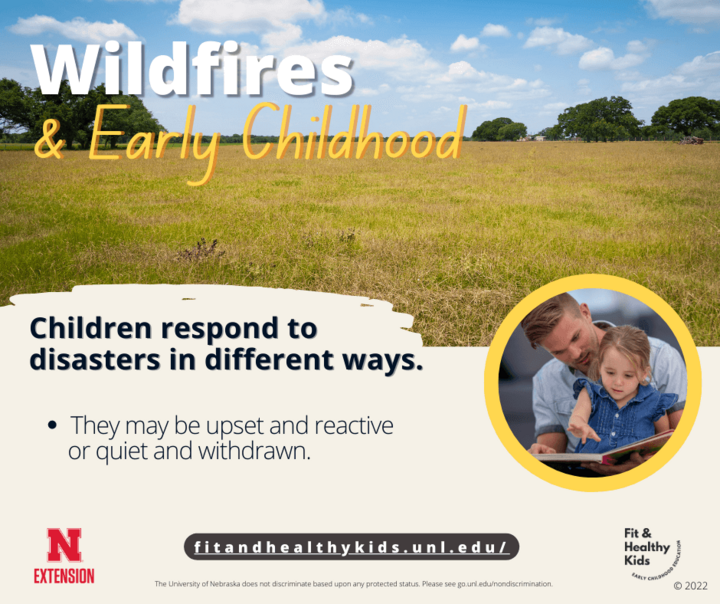
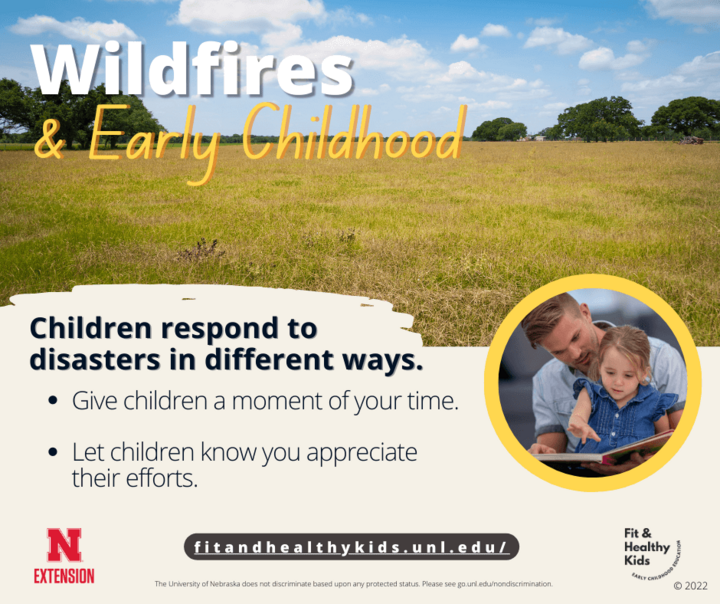
Parents and caregivers can help children by giving a moment of your time, a gentle hug, or a reassuring word to help children feel safer. Involve children in the family’s efforts to prepare for or recover from a disaster. Keep assigned tasks safe and age appropriate. Let them know you appreciate their efforts to help the family. Learn more at The Learning Child Blog.
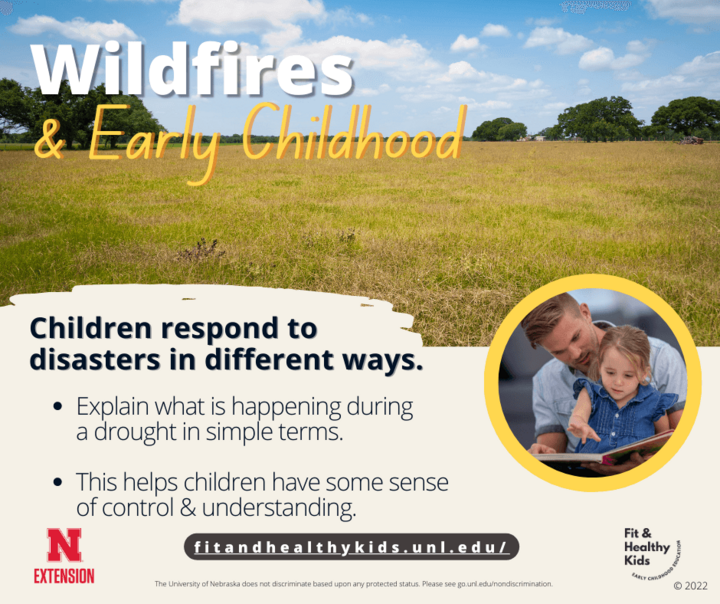
Adults can also help by keeping children informed by explaining what is happening. You can explain how a fire happens, and how these are unusual but natural patterns of weather. Children will feel safer if they have some answers. It is helpful to limit media coverage and graphic details. This helps children have some sense of control. Learn more at Nebraska Extension Early Childhood Development.
It's important for children during stressful times to maintain routines or rituals of comfort. Dinnertime at the kitchen table or reading your child’s favorite book at bedtime may provide young children with a sense of security. Children are better able to cope with a crisis if they feel they understand it and there are people working to keep the family safe. Learn more at Extension's Read for Resilience.
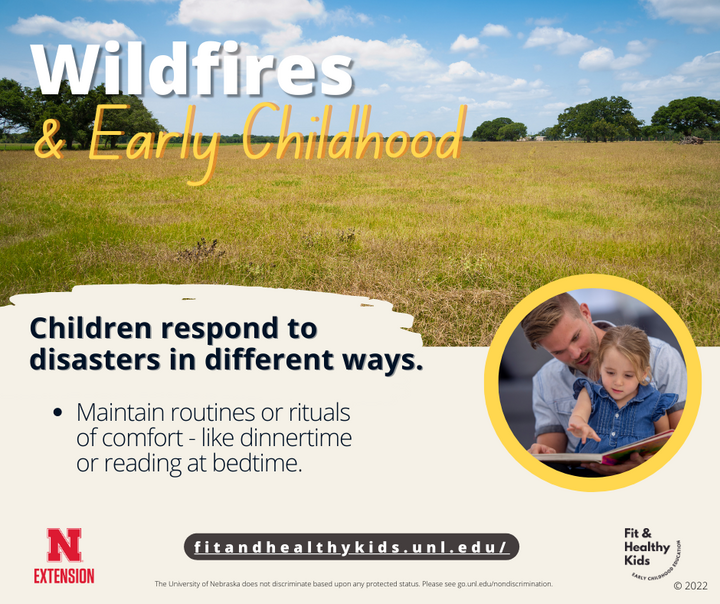
During a crisis, it's also vital to acknowledge your child’s feelings and experiences. Let your child know it is OK to cry. Encourage your child to ask questions about their uncertainties and provide a safe space for their emotions and reactions. Learn more from the extension publication, How to Help Preschoolers Manage Their Emotions After a Disaster.
